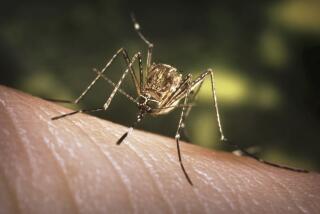Terrifying Infection Leaves 10-Year-Old Boy Missing Limbs
One day, Christopher Alex McMillian was like any other 10-year-old, playing basketball, passing notes in class, breezing through math, his favorite subject.
Twenty-four hours later, he was fighting to survive an infection called meningococcal disease--an unusual but aggressive condition that afflicts one out of 100,000 people in the United States.
Chris is expected to live, doctors say, but his life won’t be the same.
Two weeks ago, surgeons amputated his right arm and both legs. His left arm was cut to just above the elbow.
Now, he has surgeries every two to three days to reconstruct and remove damaged tissues. Chris, who lives in West Los Angeles, faces months of treatment and rehabilitation at Childrens Hospital in Los Angeles.
His family is stunned--but hopeful, because of his strong spirit.
“He’s a make-things-happen type of person,” said his grandmother, Marguerite McMillian, who prays beside his hospital bed, where he lies heavily sedated, wrapped in sterile bandages and fed by an IV.
“It will not surprise me that he gets through this and just goes full speed ahead.”
The type of infection Chris had is “very unusual,” said Dr. S. Benson Werner, chief of disease investigations for the California Department of Health Services. “But, for the person who gets it, it is absolutely devastating and shocking.”
Such devastation has prompted several states to require meningitis vaccinations for young people, although the vaccine is costly and offers limited protection.
By coincidence, 10 days after Chris became ill, state Sen. Rico Oller (R-San Andreas) introduced a bill that would require all children under age 18 to receive such vaccinations. He was moved by the plight of a family whose 18-year-old son died last summer. A hearing on the proposal is set for Wednesday.
Victims and their families are often shocked by how fast the disease progresses. “It can snuff out . . . perfectly normal people within a day or two,” Werner said.
Chris’ mother couldn’t believe how quickly her son deteriorated.
“I was trying to make it stop and everything I was doing wasn’t working,” said Sandra Mestas, 26.
On Feb. 1, the boy woke up feeling ill, with a slight fever and his leg hurt. Later in the day, he couldn’t feel his hands and feet.
“Mommy, get these gloves off of my hands, take these boots off of my feet,” his mother recalls him saying repeatedly, as numbness moved through his fingers and toes.
At the Midway Hospital emergency room in Los Angeles, doctors ran tests that all came back negative. Then they found the bacteria in his blood, Mestas said.
They pumped Chris with antibiotics and sent him to the trauma center at Childrens Hospital. As hours blurred into days, doctors tried medications to increase blood flow to Chris’ limbs.
But each day Mestas watched as the caramel-colored skin on his arms and legs turned blue, then black. His tissue was dying.
“You could just see what wasn’t working anymore,” Mestas said.
Soon doctors were talking to Mestas about amputations. With input from psychologists, they discussed how to tell Chris.
The bacteria that cause Chris’ disease are present all around us, said Werner. They live in the throats of about 10% of the healthy population.
Most people build antibodies against them and never get sick.
But for those who are not immune, the bacteria can invade the bloodstream or can infect the lining of the brain or spinal cord, causing the disease meningitis. About 10% of meningococcal infections are fatal, Werner said.
The disease can cause widespread clotting and impair the body’s natural ability to break down the clots, said Dr. Lawrence Ross, a professor of clinical pediatrics at the USC School of Medicine. Oxygen and nutrients can’t get to the limbs, and cells begin to die. Internal organs may also be damaged.
Health department officials said the state averages about 350 cases of meningococcal disease each year; Los Angeles County averages just over 60 cases.
Among this year’s victims were a 19-year-old freshman at USC who died in January and a 17-year old from Yorba Linda who died weeks later. At Folsom High School in Northern California, two students died within one month of each other, although the cases were reportedly unrelated.
Vaccines Not Cost-Effective
The infection is spread by respiratory droplets and close contact. It often starts with a fever, severe headache, and, if the disease becomes meningitis, a stiff neck.
In Chris’ case, the risk of another student at his school being infected was no greater than the infection rate for the general population, doctors say.
As a precaution, administrators at Wilshire Crest Elementary--where he is in fifth grade--were notified of his infection. Principal Gay Havard sent letters to the school’s 700 families explaining the disease. Only one child had a fever, and it was not related to Chris’ condition.
Health care providers say widespread immunizations are not routine because they are not very effective in young children and are ineffective in preventing one of the five strains of the disease. That strain causes the disease in 50% of all cases for adults and older children, Ross said.
In addition, officials said, it has not been cost-effective to mandate the $75 vaccination.
Still, states such as Maryland and Rhode Island have introduced meningitis vaccination programs in the last few years.
Development of a more effective vaccine is expected in the next few years.
Chris’ future depends not just on doctors, but on support from family and friends and his own sturdy will.
Parents and teachers at his school have raised more than $6,000 to help him and his family.
“Chris has this really big support group of people that take care of him,” said his grandmother. “When I go home and go to sleep, I don’t worry. He’s getting TLC.”
McMillian’s son, Chris’ father, died at 18 of a rare lymphoma. He only had one year to enjoy his son’s life. McMillian said that has made her even more determined to make sure Chris has everything he needs.
Sometimes she sits with Chris reciting a prayer, hoping he will remember its message of courage and wisdom.
Sometimes Chris moves the top of his left arm. Sometimes he bobs his head to his favorite CD playing on the boom box in the corner of his room. It’s hard for him to talk because he’s on a respirator. But sometimes when asked if he remembers what happened, he nods his head, and tears well in his eyes.
“To me Chris is alive, and whatever he has I’m going to work with it,” McMillian said.
During a recent visit, his grandmother rubbed his arm and said a soft hello. Chris opened his eyes when she spoke. He listened carefully and seemed to understand.
“I love you,” she told him.
In spite of the tubes, the bandages, the morphine that keeps the pain at bay, Chris moved his lips in a soundless reply,
“I love you, too,” he said.
Donations can be sent to: Wilshire Crest Student Body/McMillian Fund, Wilshire Crest Elementary School, 5241 W. Olympic Blvd., Los Angeles 90036.
More to Read
Sign up for Essential California
The most important California stories and recommendations in your inbox every morning.
You may occasionally receive promotional content from the Los Angeles Times.










